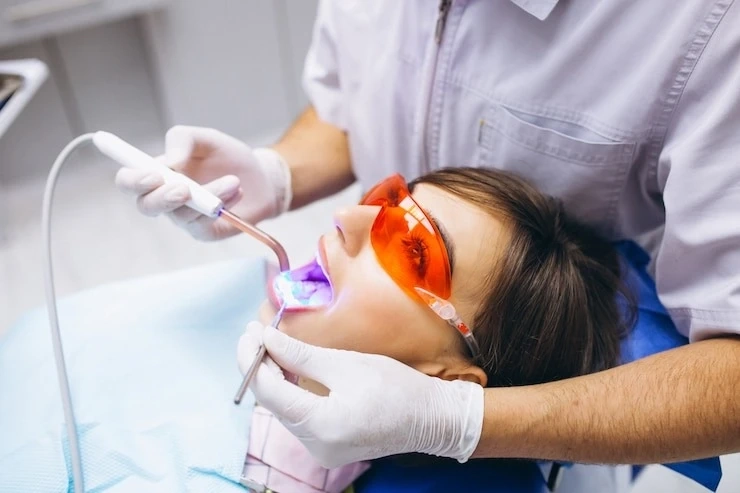A bright, white smile can leave a lasting impression and boost your confidence. Over time, however, our teeth may become stained or discolored due to various factors such as food, drinks, smoking, or the natural aging process. While at-home teeth whitening products offer a convenient solution, professional teeth whitening by a top-rated North Canton dentist is often the most effective and safest way to achieve a significantly whiter smile.
1. Consultation and Assessment
The first step in professional teeth whitening is scheduling a consultation with your dentist. During this appointment, the dentist will assess the health and condition of your teeth and gums. It’s essential to ensure that your teeth are in good condition before undergoing whitening treatment. The dentist will also discuss any pre-existing dental issues, such as cavities, gum disease, or tooth sensitivit,y that might affect the whitening process.
The dentist may also take a shade guide to compare the current color of your teeth with the desired outcome. This allows you to set realistic expectations for how white your teeth can get.
2. Cleaning Your Teeth
Before applying any whitening agent, a professional cleaning is usually performed. This step is essential because plaque and tartar buildup on the teeth can hinder the effectiveness of whitening treatments. During the cleaning, the dentist or hygienist will remove any plaque, tartar, and surface stains. This ensures that the whitening agent can direct contact with the tooth enamel for optimal results.
A thorough cleaning also helps prevent gum irritation and tooth sensitivity, which can sometimes occur when whitening treatments are applied to unclean teeth.
3. Protection of Gums and Soft Tissues
Once your teeth are cleaned, the dentist will protect your gums and soft tissues. This is a crucial step to ensure the whitening agent does not irritate these sensitive areas. A rubber dam or gel is typically applied to shield the gums, lips, and inner cheeks.
The dentist will carefully isolate the teeth to be whitened, using either a protective coating or a barrier to keep the whitening solution from touching any other soft tissue. This step helps to ensure that the whitening process is focused only on the teeth.
4. Application of Whitening Gel
After preparing the teeth and gums, the dentist will apply a professional-strength whitening gel to your teeth. This gel contains hydrogen peroxide or carbamide peroxide, the active ingredients that break down stains and discoloration in the enamel. These whitening agents penetrate the enamel and oxidize the stains, lifting the color to a lighter shade.
Depending on the whitening system, the dentist may use a special light or laser to enhance the gel’s effectiveness. The light helps to activate the chemicals in the whitening gel, accelerating the bleaching process and allowing for faster results.
5. Duration of Treatment
The whitening gel is typically left on your teeth for about 15-30 minutes, depending on the treatment used and the desired whitening level. Some treatments require multiple applications to achieve the desired result. During this time, the dentist will monitor the progress, ensuring that the gel is working effectively without causing any damage to your enamel or irritation to your gums.
In some cases, a high-intensity light or laser is used to speed up the process. These lights can help the active ingredients in the whitening gel work more efficiently, allowing the procedure to take less time.
6. Final Rinse and Aftercare
Once the whitening treatment is complete, the dentist will remove the gel and give your teeth a final rinse. They may also apply a fluoride or desensitizing gel to reduce post-treatment sensitivity. Some patients experience mild sensitivity for a few hours after whitening, but this usually subsides.
Your dentist will give you aftercare instructions, which may include recommendations on what foods and drinks to avoid in the first 24-48 hours after treatment. It’s essential to avoid items like coffee, tea, red wine, and dark-colored sauces, as your teeth may be temporarily more porous after the whitening procedure.
7. Follow-Up Visits and Maintenance
Although professional teeth whitening North Canton can produce dramatic results, maintaining the brightness of your smile requires ongoing care. Your dentist may recommend touch-up treatments, either in-office or with take-home whitening kits. Regular cleanings and good oral hygiene will also help to prolong the results.
Sometimes, the dentist may suggest lifestyle changes, such as quitting smoking or limiting staining foods and drinks to avoid further discoloration.
Conclusion
Professional teeth whitening is an excellent option for individuals who want to achieve a brighter, more youthful smile in a safe and controlled manner. The process involves several carefully executed steps, including assessment, cleaning, protection, application, and aftercare. By consulting with a dentist, you can ensure that the whitening treatment is tailored to your unique needs and that your teeth and gums are kept healthy throughout the procedure. If you’re considering professional teeth whitening, consult your dentist to determine the best treatment plan for achieving a dazzling, confident smile.



